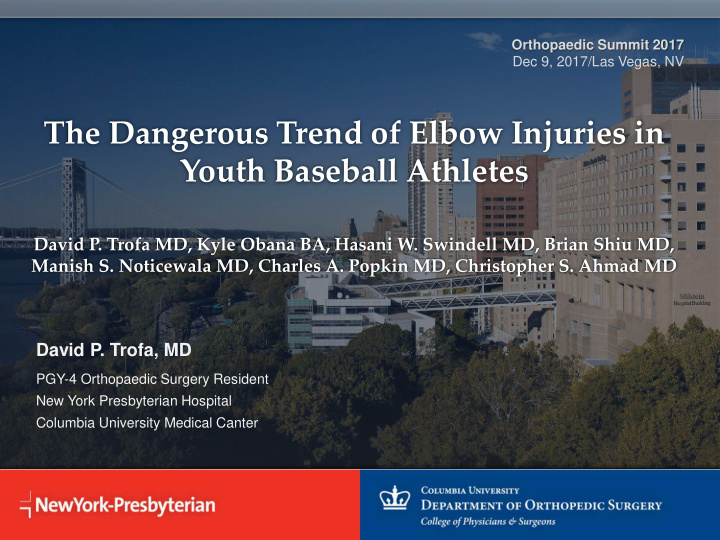



Orthopaedic Summit 2017 Dec 9, 2017/Las Vegas, NV The Dangerous Trend of Elbow Injuries in Youth Baseball Athletes David P. Trofa MD, Kyle Obana BA, Hasani W. Swindell MD, Brian Shiu MD, Manish S. Noticewala MD, Charles A. Popkin MD, Christopher S. Ahmad MD David P. Trofa, MD PGY-4 Orthopaedic Surgery Resident New York Presbyterian Hospital Columbia University Medical Canter
2 Disclosures No Financial Disclosures or Conflicts of Interest
3 Introduction • Youth athletes today are being increasingly subjected to extreme performance demands that have resulted in early sports specialization
4 Introduction • However, early specialization has not been shown to improve the odds of future elite level status • Increased the rate of overuse injuries and burnout while decreasing motivation for play. 1,2
5 Overuse Injuries in Baseball • 30% to 70% of youth throwers, develop pain in their throwing arms at some point 3 – The same study found that players are encouraged to play through pain • National survey study of 754 youth pitchers found that throwing through pain resulted in a 7-fold increase in the odds of sustaining an injury 4 • Hodgins et at. investigated the epidemiology of UCL reconstructions and found a significant increasing trend in 17 and 18 years old patients 5
6 Introduction: Overuse Injuries
7 Objective • Purpose: – To assess the efficacy of efforts to mitigate the risk of overuse injuries by analyzing national injury trends in youth players • Hypothesis 1. The total number of baseball injuries diagnosed over the past decade would decrease 2. The number of elbow injuries seen nationally would increase due to overuse injuries associated with early sports specialization
8 • Lawson et al. used the National Electronic Injury Surveillance System (NEISS) to evaluate baseball injuries presenting to United States (US) emergency rooms in players less than 18 years old between 1994-2006. 6 • Over this timeframe, the number of baseball injuries decreased by 24.9% • However, the authors did not characterize injury patterns over time
9 Methods • Study Design: • Descriptive epidemiology study using the National Electronic Injury Surveillance System (NEISS) • All cases presenting to USA emergency departments between 2006-2016 were included for review • Baseball injuries in patients 18y/o and younger were identified • Data on the injury diagnosis, location of injury, and mechanism of injury were collected
10 Results: 665,133 Baseball Injuries
11 Results: Location of Injuries
12 Results: Diagnoses
13 Results: Number of Injuries to Major Joints
14 Results: Incidence of Injuries to Major Joints
15 Results: Incidence of Injuries to the Upper Extremity
16 Summary 1. Baseball injuries continue to decrease across the nation 2. The ONLY location of injury that saw an increase in diagnosis was the elbow. • The incidence of elbow diagnoses was significantly greater (p<0.05) than diagnoses of the knee, ankle, wrist, hand and fingers. Conclusion: Despite increasing public awareness and national efforts to lower overuse injuries in throwers, elbow injuries continue to rise in adolescent baseball players. As such, new initiatives must be developed to limit these overuse injuries.
17 Limitations • All the biases inherent to utilizing a large national database • These numbers do not represent all baseball injuries in this patient population • Private clinics vs urgent care centers
18 References: 1. DiFiori JP, Benjamin HJ, Brenner JS, et al. Overuse injuries and burnout in youth sports: a position statement from the American Medical Society for Sports Medicine. Br J Sports Med. 2014;48(4):287-288. PMID: 24463910. 2. Jayanthi NA, LaBella CR, Fischer D, Pasulka J, Dugas LR. Sports- specialized intensive training and the risk of injury in young athletes: a clinical case-control study. Am J Sports Med. 2015;43(4):794-801. PMID: 25646361. 3. Makhni EC, Morrow ZS, Luchetti TJ, et al. Arm pain in youth baseball players: a survey of healthy players. Am J Sports Med. 2015;43(1):41-46. PMID: 25367016. 4. Deits J, Yard EE, Collins CL, Fields SK, Comstock RD. Patients with ice hockey injuries presenting to US emergency departments, 1990-2006. J Athl Train. 2010;45(5):467-474. PMID: 20831391. 5. Hodgins JL, Vitale M, Arons RR, Ahmad CS. Epidemiology of Medial Ulnar Collateral Ligament Reconstruction. Am J Sports Med. 2016;44(3):729-734. PMID: 26797699. 6. Lawson BR, Comstock RD, Smith GA. Baseball-related injuries to children treated in hospital emergency departments in the United States, 1994-2006. Pediatrics. 2009;123(6):e1028-34. PMID: 19482735.
19 Thank You! David P. Trofa, MD davidtrofa@gmail.com
Recommend
More recommend